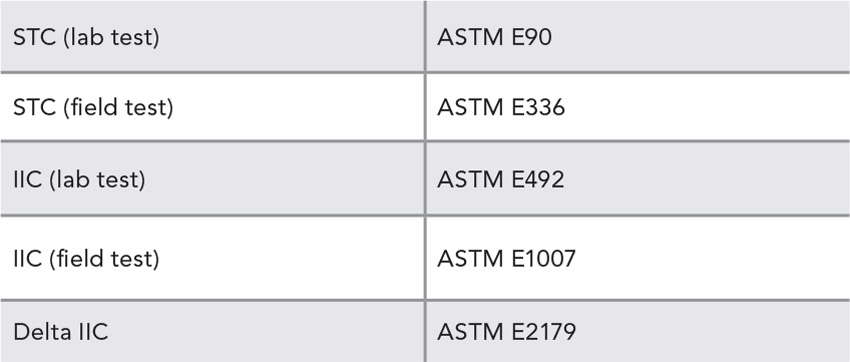This CE Center article is no longer eligible for receiving credits.
Sound vs. Noise
“Noise” is a subjective term. One person’s brilliant guitar solo might be perceived by another as a hideous racket. But in general, sounds that register as “noise” have some common characteristics: they are loud enough or of such high intensity that they are uncomfortable; they are intermittent and unpredictable rather than continuous; and they compete or interfere with the sounds you really want to hear.
The basic goal of design for good acoustics is to reduce unwanted sound and make desired sound clearer and easier to hear. This is possible because of the way soundwaves interact with different materials and barriers between sound sources and receivers (ears).
There are three basic physical possibilities for a soundwave. Sound can be:
Reflected: It bounces off the surface back into the room. This may create echoes and reverberation. Hard surfaces are highly reflective. The more reflective surfaces there are in the room, the more the echoes will bounce back and forth.
Absorbed: It hits a soft, fibrous material, where sound energy is converted into heat via friction, or a dense, resilient material like rubber, which acts more like a damper and “absorbs” sound by dissipating the acoustic energy within the material itself.
Transmitted: This can happen when a wave goes right through a thin material or an opening, like a crack or gap. It also happens when the wave causes part of the structure itself—for example, the floor or wall between two spaces—to vibrate and transmit the sound.
In general, higher frequencies are more likely to be reflected by materials in a room. The relatively long, slower wavelengths of lower sounds can more easily pass through and around materials. The simplest example is how well you can hear the bass line from music upstairs or a car going by, even if you can’t make out anything else.
In most spaces, absorbing sound within the room and blocking transmission of sound between adjacent spaces are both important. For example, in a hospital, it is critical that staff and patients can clearly understand speech in the room, so finishes should absorb excess noise. But for privacy and to control noise in the whole area, sound transmission into the corridor or between adjacent rooms needs to be controlled too.
How much sound is reflected, and how much is absorbed or transmitted, will be greatly influenced by the room’s materials. Some materials, like insulation, foam, cork or rubber, can muffle or mitigate noise. Others can dramatically increase noise—for example, from the reverberation when soundwaves impact hard surfaces like tile, stone, and glass.
This is why the testing and rating of materials is so important. They give designers verified and quantifiable ways to predict how products and materials will work in the space and enhance the way people will experience sound.
Key Numbers (And Letters)
Small changes in the ratings can make a big difference in acoustics. For flooring specifically, there are four ratings designers should understand and use when selecting surfaces.
The first, noise reduction coefficient (NRC), measures how the material absorbs sound. The second and third ratings are closely related: impact insulation class (IIC) and delta IIC (written as ∆IIC). These are measures of how structure-borne sound is transmitted from one room to the room below, through the floor-ceiling assembly. These are probably the most important factors for evaluating flooring, and also probably the most often confused. The fourth rating, sound transmission class (STC,) is a measure of airborne sound transmitted through a structure (e.g., a partition or floor-ceiling assembly), often used but with some limitations when applied to flooring.
An additional new measure relevant to flooring acoustics, surface generated sound (discussed later in the course) has been developed and is nearing release by ASTM.
But right now, the following four are the indispensable basics.
(Also, see Quick Guide to the Ratings sidebar.)
Noise Reduction Coefficient (NRC)
Based on ASTM C423: Standard Test Method for Sound Absorption and Sound Absorption Coefficients by the Reverberation Room Method
NRC measures how much sound a finish material absorbs when hit by a soundwave. Any sound the material does not absorb will either be reflected or transmitted. NRC is a single number from zero (absorbing no sound) to one (absorbing all the sound that hits it). So, for example, if a material has an NRC of 0, all the sound that hits it will be reflected back into the space. A theoretical material that absorbed all sound would have an NRC of 1. A basic smooth surface flooring might have an NRC rating of 0.20.
Rooms with very hard surfaces and low NRC ratings absorb very little sound. Most of the sound from voices, laughter, footsteps, music, chairs sliding in and out, and many other sources is reflected right back into the room and bounces around with all the other soundwaves, causing echoes, reverberations, and the perception of confused loudness.
Carpet has always been the most absorptive flooring material, particularly useful at absorbing footsteps, but as discussed below, carpet has distinct drawbacks in many applications. Some resilient flooring and underlayment products are now being engineered to offer acoustic performance approaching that of carpet.
Impact Insulation Class (IIC)
Based on ASTM E492: Standard Test Method for Laboratory Measurement of Sound Transmission Through Subfloor-Ceiling Assemblies Using the Tapping Machine
IIC is a measure of sound (in dB) transmitted through the structure from upstairs to downstairs. Impact noise is not airborne sound like a radio playing or people talking. IIC tests measure sound from impacts like high heels hitting the floor above your ceiling or heavy weights being dropped in the fitness center above. The higher the IIC rating, the more effective the floor-ceiling assembly is at isolating the vibrations and impact sound.
IIC ratings can be greatly affected by the flooring. Materials improve the IIC rating according to their physical properties. More rigid materials are less effective than materials that offer internal damping of sound. For example, the IIC of a very basic wood floor assembly with no underlayment might be 20–25. Adding an effective underlayment might give the entire floor-ceiling assembly an IIC in the 50s, dramatically reducing the transferred vibrations and thus the noise.
This measure—if used properly—is probably the most important for the accurate evaluation of acoustic flooring products, particularly when they are to be used anywhere in buildings of more than one story. According to the International Building Code (IBC), the minimum IIC rating is 50 (if using laboratory tests; 45 if testing in the field, written as FIIC). Most local building codes are based on the IBC, and most have minimum acoustic requirements for multistory buildings.
However, these are minimums and not likely to come anywhere near meeting the needs of most carefully designed spaces today, from health care and educational settings to high-end apartments.
One key thing to remember: no flooring product has an IIC rating all its own. All IIC ratings are for an entire floor-ceiling assembly. (See Quick Guide to the Ratings sidebar.) The type of materials, the thickness of the flooring and of the underlayment, the construction of the assembly, and the installation methods all make big differences that can cause wide swings in IIC ratings.
Delta IIC (∆IIC)
Based on ASTM E2179: Standard Test Method for Laboratory Measurement of the Effectiveness of Floor Coverings in Reducing Impact Sound Transmission through Concrete Floors
It’s easy to miss the small Greek letter ∆ (delta) that makes a very important difference in evaluating how much a flooring product will help reduce impact noise. “Delta” IIC, written as ∆IIC, is a way of determining the rating of the flooring product itself, subtracting it out from the total measurement for the rest of the building assembly (the concrete slab). The ∆IIC rating will give you a good idea of what the product might add to a floor-ceiling assembly.
Testing under this ASTM standard first measures the bare 6-inch concrete slab assembly without any flooring products to get a baseline IIC rating (28 is usually considered the baseline reference for a 6-inch concrete slab). Then the entire assembly is tested again after flooring products are installed for an overall IIC rating (say, 58). The difference between those two tests is the ∆IIC for the flooring products only (in this example, 30).
Understanding the distinction helps avoid unhelpful product comparisons. For example, under the standard, the base reference is 28 for a concrete floor without any flooring material. So a flooring product with a stated IIC of 35 probably only has a ∆IIC of 7—not a significant contribution. But a flooring product with a ∆IIC of 35 would indicate that the product alone contributes significant impact protection, beyond the protection provided by the slab alone.
Another important detail to understand about a ∆IIC rating is what products are included: Is it a finished flooring product alone, or did the test also include an acoustical underlayment? The same caution is true when reviewing ∆IIC ratings for underlayments. It’s important to determine which floor covering was tested in conjunction with the underlayment. Underlayments are never installed without floor coverings, and therefore their ∆IIC ratings should always include a floor covering. The same underlayment tested with different floor coverings will have different ∆IIC ratings (for example, tile vs. engineered wood over the same underlayment).
∆IIC tests at this time are only conducted over 6-inch concrete slabs with no ceiling below.
Manufacturers of effective, properly tested flooring products should be able to provide ∆IIC numbers, as well as data on alternative assemblies so that designers can make realistic comparisons based on accurate predictions of performance.
STC: Sound Transmission Class
Based on ASTM E90: Standard Test Method for Laboratory Measurement of Airborne Sound
STC is a measure of how partitions and/or floor-ceiling assemblies reduce the airborne sound being transmitted through them. A partition could be a floor/ceiling assembly, but more often STC is used to describe barriers like walls, doors, room dividers, etc. Higher values are better as they indicate less transmission of airborne sound. For example, you could probably hear loud speech through a wall with an STC of 30, but not through a wall with an STC of 60. The International Building Code specifies the same minimums for STC as for IIC: 50 if tested in the lab, and 45 in the field.
STC is primarily controlled by mass and therefore is not significantly affected by flooring systems. For example, whether a floor assembly is made of concrete slab or wood joist is going to be more of a determining factor in the STC rating of a floor-ceiling assembly than the type of floor covering used.
If you’ve ever been to a trendy new restaurant but found you couldn’t quite enjoy the beautiful decor and great food because you couldn’t hear your companions, then you understand the power of noise to distract and annoy. In many spaces, such as classrooms or hospital rooms, the stakes for poor acoustics are much higher. In fact, noise has a proven, direct impact on human health, comfort, and performance. Effective acoustic design should be a fundamental requirement of almost every space. Yet many of the most cost-effective and beneficial measures are often overlooked, misunderstood, and underutilized.
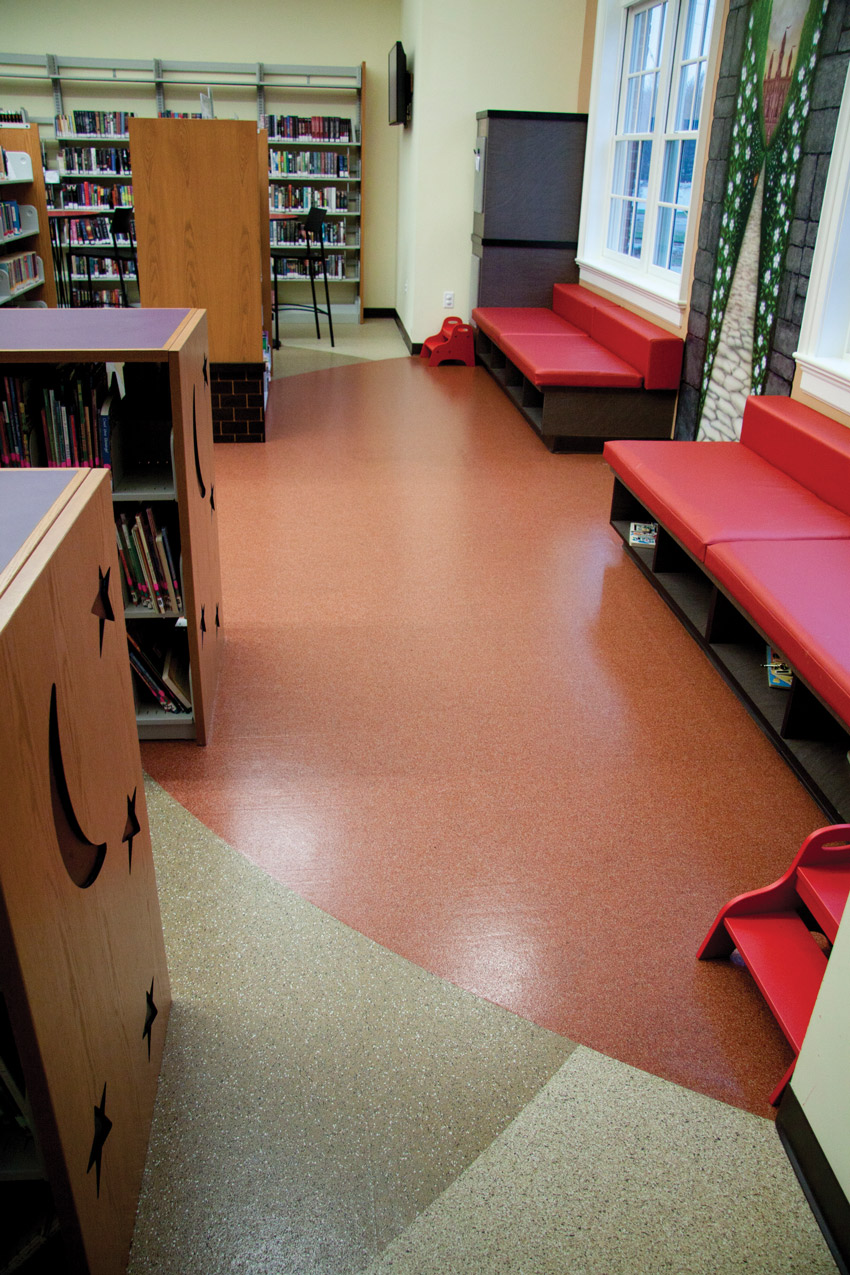
All images courtesy of Ecore International
Pendleton County Library in Falmouth, Kentucky, features 4,000 square feet of performance rubber surfacing, which the architect specified instead of carpet.
It is true that the science of acoustics is highly developed, and for many spaces the analysis may be quite complex, involving teams that include not only architects and interior designers but structural engineers, acoustic engineers, and product technical experts as well. However, there is crucial, yet basic acoustic information that every designer should know in order to ask the right questions, work effectively with the rest of the team, and demand the right kind of research, data, and support from product suppliers.
Most important, a thorough grounding in the basics of how materials affect sound in spaces can open a new range of opportunities for creative design solutions.
This course will look at some of the ways designers have used flooring in their projects to achieve effective acoustic solutions in challenging spaces.
These are some of the questions we will consider:
- What do the many standards, ratings, and acronyms such as NRC, IIC, and STC mean?
- What impact should those numbers have on the design of the flooring in an actual space?
- What are the right questions to ask when comparing the acoustic “numbers” on different products?
- Should all spaces get the same kind of solution, and if not, where can a designer find the best approach for a high-performing floor?
- What does “performance” mean for a floor?
- What should I expect from the rest of the design team, including engineers, experts and product suppliers?
- If we pull out all this carpet and replace it with a beautiful smooth surface, it’s going to look a lot better. Isn’t that all that matters?
Sound Basics
Sound is vibration. Soundwaves travel from the source of the sound to your ear. Different sounds vibrate with waves of different lengths. Wavelength is measured as the distance from crest to crest within the soundwave (Figure 2). The wavelength of a sound relates to its frequency, measured in Hertz (hz), basically how “frequently” it vibrates. Sounds with shorter wavelengths have higher frequencies. Longer, slower wavelengths correspond to lower frequencies. Sound can also be measured by intensity, the sound pressure level, measured in decibels (dB), which we perceive as relative loudness.
Figure 2: Illustration of Wavelength
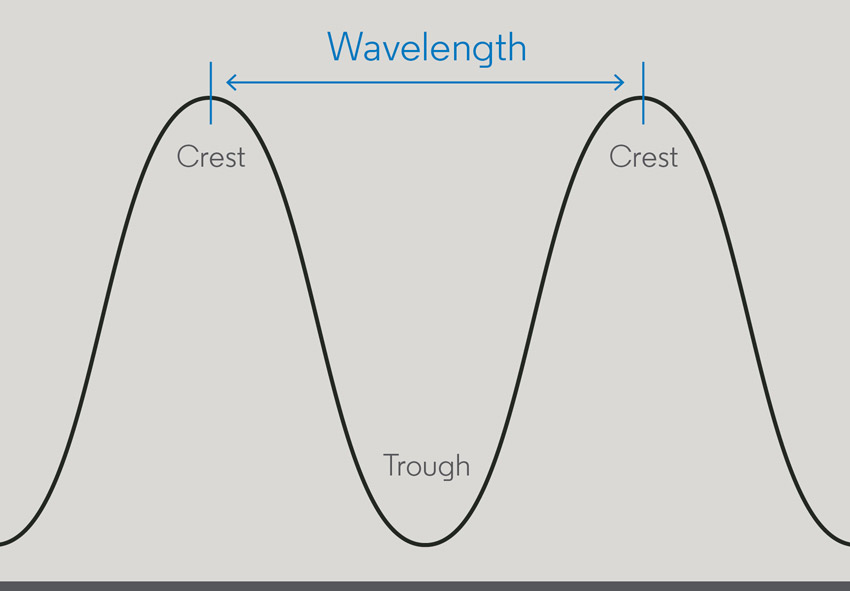
Mainly we think of soundwaves in a room as traveling through the air, but they are also interacting with the building’s materials, like the walls, ceilings, and floors. Depending on the materials and characteristics of the room, soundwaves are being absorbed or reflected or they are passing through to adjacent spaces. The soundwaves can also cause the materials themselves to vibrate, another way of transmitting the sound from room to room.
There are, of course, countless sources of audible vibrations around us all the time. The human ear can distinguish an extremely wide range of sound, from leaf rustle to leaf blower and beyond. In terms of frequency, most human speech is in the range of 125 to 4,000 Hz, but humans can perceive frequencies from about 20 Hz to 20,000 Hz.
We are also surrounded by sounds at wildly varying levels of loudness. That leaf might be rustling at 10 dB while the leaf blower might be operating at 90 dB. Serious pain and damage can start at about 100 dB. Decibels are measured on a logarithmic scale (like earthquakes and tornadoes). Every increase in 3 dB actually doubles the measured sound intensity. But it takes an increase of 10 dB to be perceived by the human ear as doubling the sound.
This may seem to be a technical point, but it has practical importance too. It is useful to know that a noisy room at 60 dB is much more than twice as loud as a quiet room at 30 dB. In fact, 33 dB has twice the intensity as 30 dB, and 40 dB will seem twice as loud to people in the room. Small differences in measured sound levels can make a big difference in perceived loudness.
The amazing sensitivity of the human ear makes it very vulnerable to noise. But music and conversation and unbearable noise are all made up of waves moving in space, so how are physical materials in a room supposed to tell the difference?
Figure 3: Common Sound Levels

Sound vs. Noise
“Noise” is a subjective term. One person’s brilliant guitar solo might be perceived by another as a hideous racket. But in general, sounds that register as “noise” have some common characteristics: they are loud enough or of such high intensity that they are uncomfortable; they are intermittent and unpredictable rather than continuous; and they compete or interfere with the sounds you really want to hear.
The basic goal of design for good acoustics is to reduce unwanted sound and make desired sound clearer and easier to hear. This is possible because of the way soundwaves interact with different materials and barriers between sound sources and receivers (ears).
There are three basic physical possibilities for a soundwave. Sound can be:
Reflected: It bounces off the surface back into the room. This may create echoes and reverberation. Hard surfaces are highly reflective. The more reflective surfaces there are in the room, the more the echoes will bounce back and forth.
Absorbed: It hits a soft, fibrous material, where sound energy is converted into heat via friction, or a dense, resilient material like rubber, which acts more like a damper and “absorbs” sound by dissipating the acoustic energy within the material itself.
Transmitted: This can happen when a wave goes right through a thin material or an opening, like a crack or gap. It also happens when the wave causes part of the structure itself—for example, the floor or wall between two spaces—to vibrate and transmit the sound.
In general, higher frequencies are more likely to be reflected by materials in a room. The relatively long, slower wavelengths of lower sounds can more easily pass through and around materials. The simplest example is how well you can hear the bass line from music upstairs or a car going by, even if you can’t make out anything else.
In most spaces, absorbing sound within the room and blocking transmission of sound between adjacent spaces are both important. For example, in a hospital, it is critical that staff and patients can clearly understand speech in the room, so finishes should absorb excess noise. But for privacy and to control noise in the whole area, sound transmission into the corridor or between adjacent rooms needs to be controlled too.
How much sound is reflected, and how much is absorbed or transmitted, will be greatly influenced by the room’s materials. Some materials, like insulation, foam, cork or rubber, can muffle or mitigate noise. Others can dramatically increase noise—for example, from the reverberation when soundwaves impact hard surfaces like tile, stone, and glass.
This is why the testing and rating of materials is so important. They give designers verified and quantifiable ways to predict how products and materials will work in the space and enhance the way people will experience sound.
Key Numbers (And Letters)
Small changes in the ratings can make a big difference in acoustics. For flooring specifically, there are four ratings designers should understand and use when selecting surfaces.
The first, noise reduction coefficient (NRC), measures how the material absorbs sound. The second and third ratings are closely related: impact insulation class (IIC) and delta IIC (written as ∆IIC). These are measures of how structure-borne sound is transmitted from one room to the room below, through the floor-ceiling assembly. These are probably the most important factors for evaluating flooring, and also probably the most often confused. The fourth rating, sound transmission class (STC,) is a measure of airborne sound transmitted through a structure (e.g., a partition or floor-ceiling assembly), often used but with some limitations when applied to flooring.
An additional new measure relevant to flooring acoustics, surface generated sound (discussed later in the course) has been developed and is nearing release by ASTM.
But right now, the following four are the indispensable basics.
(Also, see Quick Guide to the Ratings sidebar.)
Noise Reduction Coefficient (NRC)
Based on ASTM C423: Standard Test Method for Sound Absorption and Sound Absorption Coefficients by the Reverberation Room Method
NRC measures how much sound a finish material absorbs when hit by a soundwave. Any sound the material does not absorb will either be reflected or transmitted. NRC is a single number from zero (absorbing no sound) to one (absorbing all the sound that hits it). So, for example, if a material has an NRC of 0, all the sound that hits it will be reflected back into the space. A theoretical material that absorbed all sound would have an NRC of 1. A basic smooth surface flooring might have an NRC rating of 0.20.
Rooms with very hard surfaces and low NRC ratings absorb very little sound. Most of the sound from voices, laughter, footsteps, music, chairs sliding in and out, and many other sources is reflected right back into the room and bounces around with all the other soundwaves, causing echoes, reverberations, and the perception of confused loudness.
Carpet has always been the most absorptive flooring material, particularly useful at absorbing footsteps, but as discussed below, carpet has distinct drawbacks in many applications. Some resilient flooring and underlayment products are now being engineered to offer acoustic performance approaching that of carpet.
Impact Insulation Class (IIC)
Based on ASTM E492: Standard Test Method for Laboratory Measurement of Sound Transmission Through Subfloor-Ceiling Assemblies Using the Tapping Machine
IIC is a measure of sound (in dB) transmitted through the structure from upstairs to downstairs. Impact noise is not airborne sound like a radio playing or people talking. IIC tests measure sound from impacts like high heels hitting the floor above your ceiling or heavy weights being dropped in the fitness center above. The higher the IIC rating, the more effective the floor-ceiling assembly is at isolating the vibrations and impact sound.
IIC ratings can be greatly affected by the flooring. Materials improve the IIC rating according to their physical properties. More rigid materials are less effective than materials that offer internal damping of sound. For example, the IIC of a very basic wood floor assembly with no underlayment might be 20–25. Adding an effective underlayment might give the entire floor-ceiling assembly an IIC in the 50s, dramatically reducing the transferred vibrations and thus the noise.
This measure—if used properly—is probably the most important for the accurate evaluation of acoustic flooring products, particularly when they are to be used anywhere in buildings of more than one story. According to the International Building Code (IBC), the minimum IIC rating is 50 (if using laboratory tests; 45 if testing in the field, written as FIIC). Most local building codes are based on the IBC, and most have minimum acoustic requirements for multistory buildings.
However, these are minimums and not likely to come anywhere near meeting the needs of most carefully designed spaces today, from health care and educational settings to high-end apartments.
One key thing to remember: no flooring product has an IIC rating all its own. All IIC ratings are for an entire floor-ceiling assembly. (See Quick Guide to the Ratings sidebar.) The type of materials, the thickness of the flooring and of the underlayment, the construction of the assembly, and the installation methods all make big differences that can cause wide swings in IIC ratings.
Delta IIC (∆IIC)
Based on ASTM E2179: Standard Test Method for Laboratory Measurement of the Effectiveness of Floor Coverings in Reducing Impact Sound Transmission through Concrete Floors
It’s easy to miss the small Greek letter ∆ (delta) that makes a very important difference in evaluating how much a flooring product will help reduce impact noise. “Delta” IIC, written as ∆IIC, is a way of determining the rating of the flooring product itself, subtracting it out from the total measurement for the rest of the building assembly (the concrete slab). The ∆IIC rating will give you a good idea of what the product might add to a floor-ceiling assembly.
Testing under this ASTM standard first measures the bare 6-inch concrete slab assembly without any flooring products to get a baseline IIC rating (28 is usually considered the baseline reference for a 6-inch concrete slab). Then the entire assembly is tested again after flooring products are installed for an overall IIC rating (say, 58). The difference between those two tests is the ∆IIC for the flooring products only (in this example, 30).
Understanding the distinction helps avoid unhelpful product comparisons. For example, under the standard, the base reference is 28 for a concrete floor without any flooring material. So a flooring product with a stated IIC of 35 probably only has a ∆IIC of 7—not a significant contribution. But a flooring product with a ∆IIC of 35 would indicate that the product alone contributes significant impact protection, beyond the protection provided by the slab alone.
Another important detail to understand about a ∆IIC rating is what products are included: Is it a finished flooring product alone, or did the test also include an acoustical underlayment? The same caution is true when reviewing ∆IIC ratings for underlayments. It’s important to determine which floor covering was tested in conjunction with the underlayment. Underlayments are never installed without floor coverings, and therefore their ∆IIC ratings should always include a floor covering. The same underlayment tested with different floor coverings will have different ∆IIC ratings (for example, tile vs. engineered wood over the same underlayment).
∆IIC tests at this time are only conducted over 6-inch concrete slabs with no ceiling below.
Manufacturers of effective, properly tested flooring products should be able to provide ∆IIC numbers, as well as data on alternative assemblies so that designers can make realistic comparisons based on accurate predictions of performance.
STC: Sound Transmission Class
Based on ASTM E90: Standard Test Method for Laboratory Measurement of Airborne Sound
STC is a measure of how partitions and/or floor-ceiling assemblies reduce the airborne sound being transmitted through them. A partition could be a floor/ceiling assembly, but more often STC is used to describe barriers like walls, doors, room dividers, etc. Higher values are better as they indicate less transmission of airborne sound. For example, you could probably hear loud speech through a wall with an STC of 30, but not through a wall with an STC of 60. The International Building Code specifies the same minimums for STC as for IIC: 50 if tested in the lab, and 45 in the field.
STC is primarily controlled by mass and therefore is not significantly affected by flooring systems. For example, whether a floor assembly is made of concrete slab or wood joist is going to be more of a determining factor in the STC rating of a floor-ceiling assembly than the type of floor covering used.
Different Floors For Different Needs
All spaces need a basic level of acoustical performance for health, function, and safety. But some need more targeted solutions than others. Clearly, an auditorium or a recording studio has highly specialized needs, but most building types also have specific requirements that relate to their function. At the same time, there is always a cost benefit analysis. For owners who have an ongoing stake in the building, reducing maintenance and replacement costs will be especially important. For spaces like hospitals and classrooms, there are published technical guidelines, some of which are noted below. Along with these requirements, acoustic flooring solutions also have to provide comfort and safety, low maintenance, and high sustainability.
It’s important to note that in any room or building as a whole, the flooring system is only one of many factors affecting acoustics. Designing the layout of the room to direct sound, locating it to avoid noise sources, adding structural components like partitions and ceilings to interrupt the path of sound, using resilient channels, and minimizing openings in the assembly are all effective strategies, just to name a few. However, flooring is one of the most effective pieces of the solution, just as it can be a big part of the problem if not designed properly. Everyone in the space interacts daily with the floor. It will have a direct impact on them every minute they’re in the room.
The following are different types of applications where flooring is selected for acoustic performance, along with examples and key points specific to each:
Health Care
Health-care facilities include a broad range of buildings, from hospitals to new targeted specialty care centers, such as orthopedics, urgent care, outpatient rehabilitation, and new types of assisted and independent living facilities. The importance of the physical environment to patient outcomes has been extensively documented over several decades, including the powerful role of quiet surroundings in a patient’s healing and well-being and the staff’s effectiveness and safety.
Relevant published standards include:
- Sound & Vibration: Design Guidelines for Health Care Facilities by the Facility Guidelines Institute (FGI)
- Guidelines for supporting the Health Insurance Portability and Accountability Act (HIPAA), to ensure sound isolation and speech privacy
Recommended daytime noise levels for patient areas in health-care facilities is 35 dB. With constant noise sources from equipment, monitors, carts, staff, other patients and visitors, this target is difficult to achieve. Flooring also has to be kept scrupulously clean to help in ongoing efforts to control infection, and it must be safe, helping to control infection, prevent falls, and reduce severity of injury when falls do occur.
Perhaps because flooring is so visible and has such an impact on positive outcomes, there are many remarkable examples of innovative flooring design in health-care settings all over the world. For example, the vast Sheikh Shakhbout Medical City (Figure 5) in Abu Dhabi, the capital of the United Arab Emirates, is designed to the highest international standards and deploys state-of-the-art medical equipment and materials. Flooring selected for waiting areas and children’s play areas throughout the 300,000-square-foot facility features performance rubber surfacing that provides a superior ergonomic and acoustic solution for patients and staff.
Figure 5

The Sheikh Shakhbout Medical City, located in Abu Dhabi in the United Arab Emirates, features 2,278 square feet of a 3.2-millimeter-thick performance rubber surface fusion bonded to a 12-millimeter performance backing, resulting in a superior ergonomic and acoustic experience for staff and patients.
Figure 6

Johns Hopkins Hospital in Baltimore features 10,752 square feet of a heterogeneous vinyl sheet fusion-bonded to 5 millimeters of performance rubber. The result: a surface that reduces the risk of injury associated with falls and offers sound control and comfort underfoot.
When Johns Hopkins Hospital (JHH) (Figure 6) in Baltimore decided to replace its carpet, the design team tested 20 different alternatives, including vinyl, rubber, composites, and various combinations of backings. “We can’t keep carpet clean,” says Teri Bennett, RN, CID, CHID, IIDA, NIHD, EDAC, lead interior designer in the Architecture & Planning Department at JHH. Under the direction of the hospital’s Facility Planning and Maintenance Team, JHH conducted a system-wide multidisciplinary research floor testing study based on FGI/ASHE Guidelines on surfaces and furnishings for health-care facilities.
The testing looked at criteria for cleaning, sustainability, low-VOC, infection control, and other issues, such as eliminating high-gloss surfaces that can challenge aging or compromised vision. But one key criterion was acoustic performance.
Using rolling carts, JHH conducted acoustic tests for all 20 products, in an outdoor corridor estimated to get 20,000 footfalls a day. “The entire side we were testing acoustics on was really interesting,” says Andrea Hyde, AAHID, MDCID, planner designer in the Architecture & Planning Department at JHH. “You hit granite tile, then you rolled over our resilient floor, then you hit granite tile again, and then you rolled over the acoustic test floor. We felt the products we were testing on that side, including the one we selected, were truly making a sound difference.” The product ultimately chosen for 56 patient rooms in JHH’s new Meyer Neuro & Rehab facility is a no-wax vinyl surface fusion-bonded to a 5-millimeter recycled rubber backing.
Education
The need for good acoustics in education is fundamental: children (or learners of any age) can’t learn and teachers can’t teach if they can’t hear and make themselves understood. Quiet learning spaces contribute to focus and reduce distraction.
In general, learning spaces should isolate both interior and outdoor noise and should achieve indoor levels below 40 dB.
The Acoustical Society of America (ASA) publishes numerous guidelines for improving acoustics in the classroom, including ANSI/ASA S12.60-2010/Part 1 American National Standard Acoustical Performance Criteria, Design Requirements, and Guidelines for Schools. Inferior acoustics in education is a real problem for many students and teachers. In many classrooms in the United States, it is estimated that the speech intelligibility rating is 75 percent or less, meaning that listeners with normal hearing can understand only 75 percent of the words read from a list (Classroom Acoustics I, available on ASA’s website).
Flooring materials in schools must also ensure safety, fall prevention, and injury mitigation, along with low maintenance for tight operating budgets. They can also be an innovative part of the educational process itself. A colorful example is the Architecture and Urban planning classroom of City Hall Academy at the Tweed Courthouse (Figure 7). The entire floor is a waterjet-cut technicolor map of New York City. The recycled rubber flooring was chosen to meet a number of practical demands too, including providing excellent acoustics in a challenging space with high ceilings of hard plaster where sound reverberation could be a problem. “The recycled rubber flooring is softer than VCT, making it easier on the body and quieter,” Steven Brooks of Loffredo Brooks Architects points out. “It’s also warmer to the touch.”
Figure 7
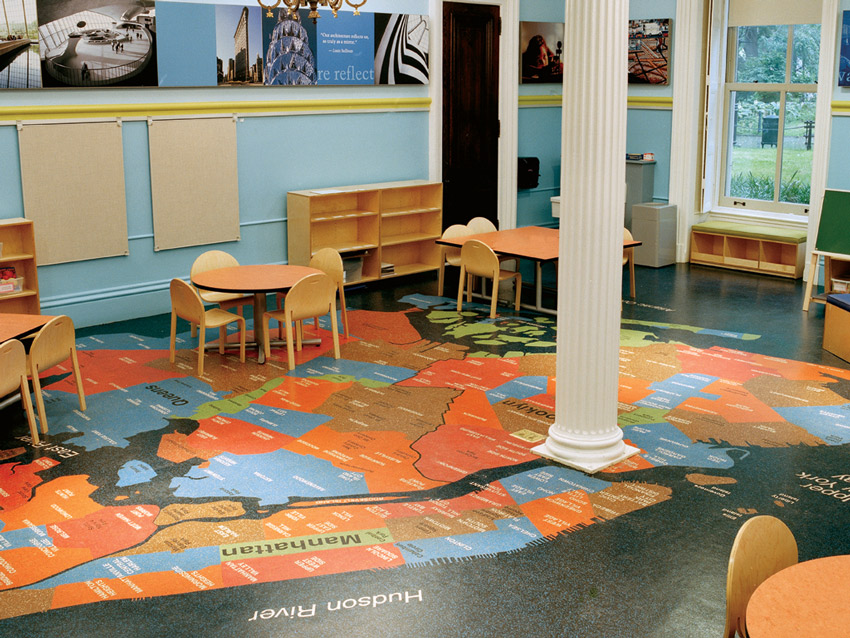
The Architecture and Urban Planning classroom of City Hall Academy at the Tweed Courthouse in New York City includes 16,736 square feet of a 3.2-millimeter-thick performance rubber surface that reduces reverberation in a building with high ceilings of hard plaster, while also delivering a colorful geography lesson.
Multifamily
As mentioned earlier, most local building codes have strict minimums on acoustic ratings. Also, the Guide to Airborne, Impact, and Structure-Borne Noise Control in Multifamily Dwellings, published by U.S. Department of Housing and Urban Development, sets standards for controlling noise in multifamily dwellings.
But building code minimums are not sufficient for much of today’s construction, notably the new high-end urban complexes being built or renovated in large numbers all over the country to accommodate changing demographics. Flooring that helps absorb sound (high NRC rating) and reduce sound transmission (high IIC rating) is essential for peace, privacy, and sleep.
One strategy for controlling sound, particularly sound transmission, while still using a variety of surfaces is to use effective underlayments developed to provide sound control when installed in different configurations. In the Bard’s Crossing condominium development in Rosemount, Minnesota, (Figure 8) recycled rubber acoustic soundproofing mats were used as part of specially designed open-web floor/ceiling assemblies to control sound in a large, senior-targeted complex. The objective was to give the residents exceptional but cost-effective sound-reduction levels when installed under many different surfaces. According to Mike Vallez, project manager of design and construction for the developer Wensmann Homes, the choice of sound insulation “produced the highest IIC ratings of anything we’ve used. We were extremely satisfied with the results: IIC field ratings of 64 with wood, 55 with ceramic tile, and 56 with vinyl.”
Figure 8

“When people are buying condos, they don’t want to hear the neighbors walking all over the place, so acoustics are important,” says Mike Vallez, project manager of design and construction for Wensmann Homes, the developers of many projects including Bard’s Crossing, a retirement community condominium in a suburb of St. Paul, Minnesota. The flooring solution included 83,000 square feet of a rubber sound-control underlayment that provided better noise deadening than other sound-insulation products used in previous projects.
Fitness and Hospitality
Fitness and hospitality buildings are included together here for two reasons. First, because sound transmission (measured particularly by IIC and ∆IIC ratings) is a key issue in both types. And second, because the two functions are more and more often found in close physical proximity. Impressive, well-equipped fitness spaces are an essential component of most hotels, as well as most full-service urban residential and multipurpose buildings. Sound transmission between rooms and floors is a constant issue. In hotels (as well as restaurants and dedicated fitness clubs) operating in our world of instant viral reviews, noise in the wrong place at the wrong time can have lasting impact on the bottom line. In many urban buildings, there are bars, restaurants, living spaces, and fitness areas close together.
For the users of fitness spaces, flooring can improve safety and performance while isolating sound between one space, say the tango aerobics class, and another, possibly a restorative yoga class.
For neighbors of fitness spaces, they are better isolated from loud noises such as pounding feet and dropped weights.
Vive on the Park (Figure 9), an upscale apartment complex in San Diego has a slogan that could apply to new and renovated buildings going up in many urban neighborhoods: “Luxe living in the middle of it all.” The state-of-the-art, multilevel fitness center is located on an upper level of the multistory apartment complex. Since there are residential units below the gym, acoustic surfacing was required to control sound. The products that were chosen featured recycled rubber backing with a number of different surfaces coordinated with the sleek, contemporary styling of the rest of the building.
Figure 9
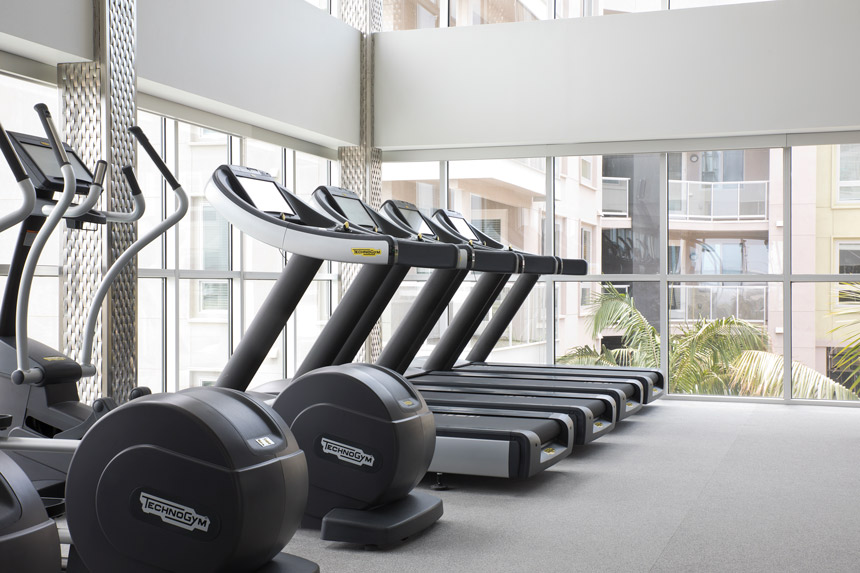
Vive on the Park is a multistory apartment complex in San Diego where the fitness center is located above residences. Designers specified engineered vinyl, turf, and rubber surfaces with a performance rubber backing in order to control sound.
NuStyle Development Corporation (NDC) had a similar design challenge, and it took more than one try to find just the right solution. NDC is credited with helping to transform downtown Omaha, and among many remarkable buildings restored by the company is The Slate on N. 19th St. After a period of product testing, recycled rubber underlayment was installed in the building’s fitness areas (Figure 10), with the specific objective of reducing sound transmission between floors to the apartments below.
The first approach, using a 5-millimeter recycled rubber sound-control underlayment, made a significant positive difference—but some sound was still being transmitted to the apartments downstairs. “While the decibel drop between the weight area and the floor below performed above apartment standards (achieving FIIC 67 where code requirements are FIIC 45), we still needed something a bit more insulating for the weight rooms,” says Greg Rothermel, development director for NDC. NuStyle Developers again approached the technicians at the same manufacturer, asking for further suggestions to eliminate sound transmission caused by the treadmills and free weights.
Additional tests were performed, including standard IIC tapping machines tests, treadmill tests, and 50-pound dumbbell drop tests. Based on the results, the company recommended a 2.5-inch rubber tile to be installed on top of the existing sound-control underlayment. The developer was so pleased with the results that variations of the system have since been installed in two other NDC properties, so the residents are peacefully free of treadmill and weight drop noise too.
Figure 10
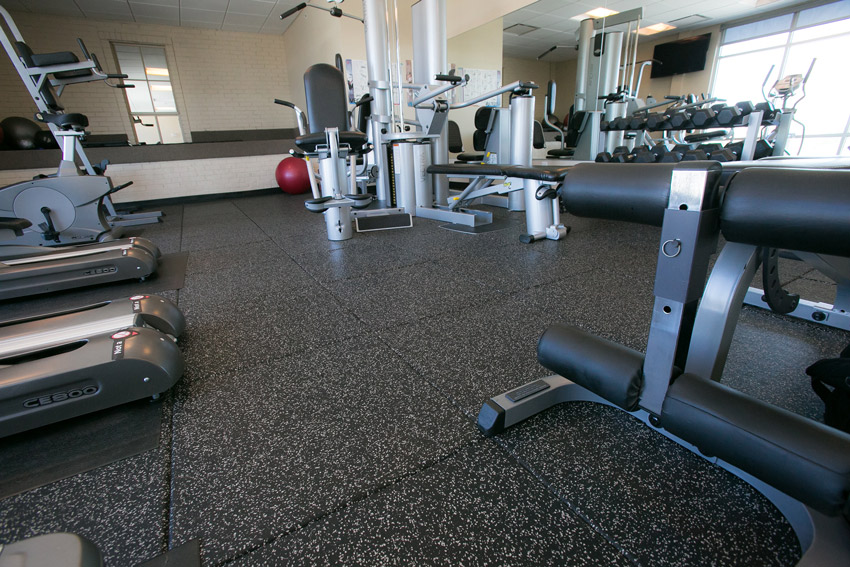
The Slate in Omaha, Nebraska, features a fitness center surrounded by apartments. The developers specified a 2.5-inch rubber tile with a 5-millimeter rubber underlayment to prevent weight room noise from traveling to rooms below it.
Out With The Carpet, In With …
Issues related to acoustic performance in all types of buildings, both commercial and residential, are getting more attention lately because of significant shifts in flooring trends away from carpet in favor of tile, marble, granite, and hardwood. Carpet has always been the go-to material to muffle sound. In fact, in some condo associations and apartment complexes, there are long-standing rules requiring a certain amount of carpet to prevent noise in adjacent spaces.
As we’ve seen, carpet is becoming steadily less desirable in today’s interiors. It is difficult to clean and almost impossible to disinfect, so it cannot be used at all in many health-care and education settings, where it has the added disadvantage of making equipment more difficult to maneuver. Carpet can also look dirty even when it’s well maintained.
But carpet has always had one advantage: acoustics. Carpet absorbs sound and vibration to a high degree. Carpet might fall short of today’s modern, streamlined aesthetic, but beautiful hard-surfaced flooring can create real noise problems.
Owners who want to take out carpet and replace it with hard flooring can get a big (and not pleasant) surprise in how noisy they are. Hard flooring might look and clean better, but that may not matter to occupants struggling to hear each other or neighbors dealing with increased noise.
Beyond acoustic considerations, replacing carpet means paying attention to important safety factors. Those hard materials so desirable in today’s interiors such as stone, tile, and hardwood are inherently less forgiving than carpet, which in sufficient thickness could offer a measure of protection against injuries from falls.
So a focus of research into flooring surface and underlayment technologies has been to combine increased acoustic benefits with the other positive performance attributes of resilient flooring. For example, a study by The Acoustics Laboratory at the University of Hartford in Hartford, Connecticut, examined the acoustic performance of common flooring products in health-care settings. The levels of sound from common sources of hospital noise, such as footfalls, corridor noise, and rolling carts, were measured under controlled conditions simulating rooms with common carpet, vinyl, and rubber flooring surfaces. The study aimed to establish ways to measure surface-generated sound in order to quantify how much a flooring material contributes to the actual quietness of a room, beyond the usual NRC measure of how much sound a material absorbs. The results of the testing indicated that a no-wax vinyl surface fusion-bonded to a 90 percent post-consumer recycled rubber backing provided the same level of quiet as carpet.
This type of engineered surfacing—a resilient floor bonded to a recycled rubber underlayment—was used in the Paseo Verde Library in Henderson, Nevada, to replace its 12-year-old shredded and discolored carpet. The library wanted to create a more inviting, contemporary atmosphere but also required durability and acoustic performance to stand up to the noise and traffic generated by the library’s adjacent cafe. “We wanted something that was easier to clean and would last longer than carpet, and we were willing to sacrifice a bit of noise to have the new floor,” says Library Manager Joan Dalasung. “But it’s just as quiet as carpet; we have been very happily surprised about that. It’s not just people walking across it; we are constantly rolling book carts and small furniture over it, and it has not only held up wonderfully, but the space has also remained quiet. It has surpassed our expectations on an acoustic level.”
Consider the Options
Flooring options today are virtually limitless, but one effective way to narrow down the choices is to specify based on acoustics. In terms of good acoustic performance, there are three basic choices:
- A resilient floor composed of material that can inherently mitigate the vibration that creates sound, such as rubber or cork. Recycled rubber flooring is practical in many more applications than cork flooring, with similar inherent sound-reducing characteristics. Recycled rubber is an extremely sustainable product that also provides specific acoustic, ergonomic, and fall-protection benefits. Some uniquely sustainable performance surfacing is created from reclaimed waste, such as tires and post-industrial and post-consumer waste. The most advanced recycled rubber surfaces offer force reduction, energy return, durability, and an unlimited range of colors, patterns, and custom design possibilities.
- A hard or smooth flooring surface, adding a performance backing or underlayment composed of a sound-mitigating material. Effective underlayments are typically rubber, cork, or foam. The key property of an underlayment is internal damping of vibration, a fundamental attribute of rubber, which is resilient and behaves much like a spring. Good, resilient underlayment must also be water resistant and strong enough to support finished flooring. Cork is often too expensive and requires skillful handling. Foam is often the least-expensive option but is not considered highly durable.
- An engineered system combining a variety of surfaces with built-in performance underlayment. In recent years, new technology has been developed that allows a wide variety of surfaces to be fusion-bonded to a recycled rubber backing to create a single high-performance acoustic system.
Figure 11

Shown is an example of an engineered flooring system with a no-wax vinyl, wood-look surface fusion bonded to a recycled rubber performance layer to provide excellent acoustic and ergonomic performance.
Help From Experts
The design of flooring systems for acoustic performance might involve architects, interior designers, acoustic engineers, and structural engineers. In spaces like performance venues, production studios, or conference rooms with advanced presentation capabilities, a detailed analysis and balancing of sound absorption, reflection, and transmission will be required. But often it is a collaboration on a different scale, where the interior designer works directly with product technical experts.
Product manufacturers can often offer a range of technical expertise. Some companies also provide research and testing on their products and offer tailored solutions. Some companies can also help with other related product requirements, such as International Code Council Evaluation Service (ICC-ES) reports evaluating specific often-used assemblies and UL-listed fire rated designs. Some manufacturers maintain large databases of test reports on product ratings and installations.
Manufacturers should also be able to offer detailed information about how products can contribute to LEED points and other sustainability criteria.
Bottom Line
The floor should make a significant, positive contribution to effective acoustics in virtually every space. Designers now have all the tools they need to make decisions that will improve the health, comfort, and mental and physical performance of the people in those spaces for years to come.

|
Ecore transforms reclaimed materials into performance surfaces that make people’s lives better. What started with cork has evolved into a portfolio of surfaces solving complex problems in applications ranging from weight rooms to hospitals. Ecore serves the athletic, fitness, healthcare, hospitality, corporate, multi-family, education, and public space markets.
www.ecoreintl.com
|

